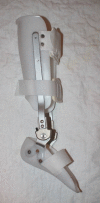Simulated Ankle Equinus Affects Knee Kinematics During Gait
- PMID: 26855626
- PMCID: PMC4733689
- DOI: 10.1007/s11420-015-9474-4
Simulated Ankle Equinus Affects Knee Kinematics During Gait
Abstract
Background: It is critical to distinguish gait compensations from true abnormalities when planning interventions to improve gait in individuals with neuromuscular disorders.
Questions/purposes: The aim of this study was to determine the effect of isolated ankle equinus on knee kinematics during the initial contact phase of gait.
Methods: Ten healthy subjects (29 + 4.3 years) participated, and testing occurred in a motion analysis laboratory. This cross-sectional study investigated five gait conditions in each subject: shoe alone, shoe with unilateral ankle foot orthosis locked at neutral, 10°, 20°, and 30° of fixed ankle plantar flexion. Gait kinematics were recorded and calculated with 3D motion analysis. The difference between the shoe and each brace condition was analyzed by repeated-measures ANOVA. The primary outcome was knee flexion at initial contact.
Results: With greater than 10° simulated ankle equinus, the primary gait compensation pattern was increased knee flexion at initial contact. A significant degree of knee flexion occurred ranging from 7° to 22°.
Conclusion: Our data suggests that observed knee flexion at initial contact may be a compensation pattern in individuals with >10° ankle equinus. However, in individuals with ≤10° ankle equinus, observed knee flexion may represent a true gait deviation. This has clinical significance in the realm of cerebral palsy for treatment planning to improve gait.
Keywords: cerebral palsy; equinus; gait; gait compensations; knee flexion; knee kinematics.
Figures
References
-
- Abel MF, Damiano DL, Blanco JS, et al. Relationships among musculoskeletal impairments and functional health status in ambulatory cerebral palsy. J Pediatr Orthop. 2003;4:535–541. - PubMed
-
- Cook RE, Schneider I, Hazlewood ME, Hillman SJ, Robb JE. Gait analysis alters decision-making in cerebral palsy. J Pediatr Orthop. 2003;3:292–295. - PubMed
-
- DeLuca PA, Ounpuu S, Davis RB, Walsh JH. Effect of hamstring and psoas lengthening on pelvic tilt in patients with spastic diplegic cerebral palsy. J Pediatr Orthop. 1998;6:712–718. - PubMed
LinkOut - more resources
Full Text Sources
Other Literature Sources



